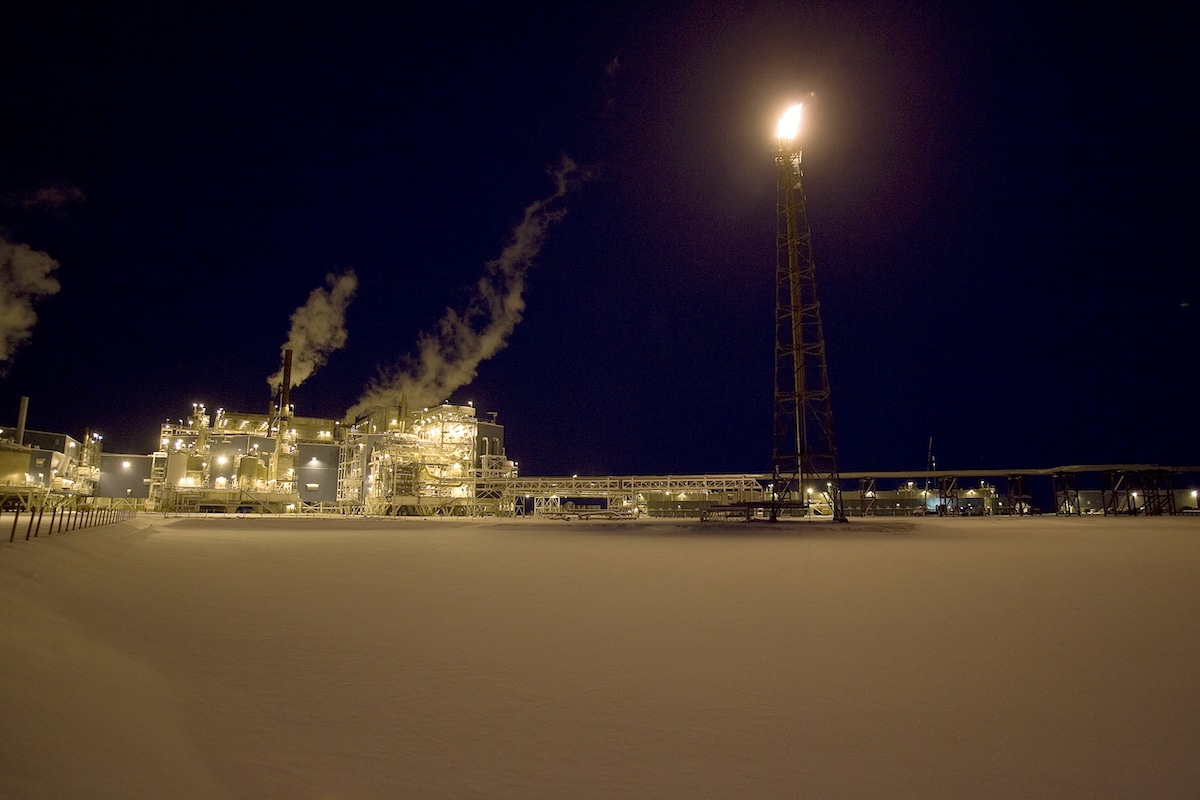Oil production in Prudhoe Bay, just outside Alaska’s Arctic National Wildlife Refuge. David Howells / Corbis via Getty Images
Founded in 2005 as an Ohio-based environmental newspaper, EcoWatch is a digital platform dedicated to publishing quality, science-based content on environmental issues, causes, and solutions.
In the Arctic, 85 percent of areas affected by artificial light at night (ALAN) are because of industrial activities, not urban development, indicating the rapid increase of these destructive undertakings in the region.
Human activity affected more than 800,000 square kilometers in the Arctic in 2013, a press release from the University of Zurich (UZH) said.
According to the UZH-led international team of researchers, the results of the study are important for nature conservation and sustainable development in the highly vulnerable region.
“More than 800,000 km2 were affected by light pollution, corresponding to 5.1% of the 16.4 million km2 analyzed, with an annual increase of 4.8%,” said Gabriela Schaepman-Strub of the Department of Evolutionary Biology and Environmental Studies at UZH, in the press release.
Climate change is affecting the Arctic more than the rest of the planet. Since 1979, the average temperature has increased by approximately three degrees Celsius — nearly four times more rapidly than the global average.
Some of the most fragile ecosystems on Earth are located in the region surrounding the North Pole, which have experienced low levels of disturbance from humans for decades.
As warming has increased, so has the Arctic’s accessibility, encouraging more urban and industrial development.
“Understanding where and what kind of human activities take place is key to ensuring sustainable development in the region — for both people and the environment. Until now, a comprehensive assessment of this part of the world has been lacking,” the press release said.
Today, human activity is evident in more than five percent of this formerly pristine region.
The researchers, including colleagues from NASA, used ALAN data observed from satellites to pinpoint hotspots and the progression of human activity between 1992 and 2013.
The researchers found that the main hotspots of human activity were in Alaska’s gas and oil extraction regions, the European Arctic and Russia, where as much as a third of land area was illuminated. In comparison, the Canadian Arctic was mostly dark at night.
“We found that, on average, only 15% of the lit area in the Arctic contained human settlements, which means that most of the artificial light is due to industrial activities rather than urban development. And this major source of light pollution is increasing in both area and intensity every year,” said Cengiz Akandil, first author of the study and a doctoral student with Schaepman-Strub’s team, in the press release. “In the vulnerable permafrost landscape and tundra ecosystem, even just repeated trampling by humans, and certainly tracks left by tundra vehicles, can have long-term environmental effects that extend well beyond the illuminated area detected by satellites.”
The study, “Artificial light at night reveals hotspots and rapid development of industrial activity in the Arctic,” was published in the journal Proceedings of the National Academy of Sciences.
The negative impacts of light pollution and industrial activities have damaging effects on Arctic biodiversity. ALAN reduces Arctic reindeer’s ability to adapt to winter twilight’s extreme blue color, which is essential for them to be able to locate food and escape predators. It also delays the breaking of leaf buds and leaf coloration — critical for species in a region with a limited growing season.
The researchers estimate that human activity’s impacts on Arctic ecosystems could exacerbate or even exceed those of human-caused climate change in the future. If industrial development continues to grow at the rate it did from 1940 to 1990, 50 to 80 percent of the Arctic could reach critical levels of disturbance from human activities by mid-century.
“Our analyses on the spatial variability and hotspots of industrial development are critical to support monitoring and planning of industrial development in the Arctic. This new information may support Indigenous Peoples, governments and stakeholders to align their decision-making with the Sustainable Development Goals in the Arctic,” Schaepman-Strub said.
Subscribe to get exclusive updates in our daily newsletter!
By signing up, you agree to the Terms of Use and Privacy Policy & to receive electronic communications from EcoWatch Media Group, which may include marketing promotions, advertisements and sponsored content.
